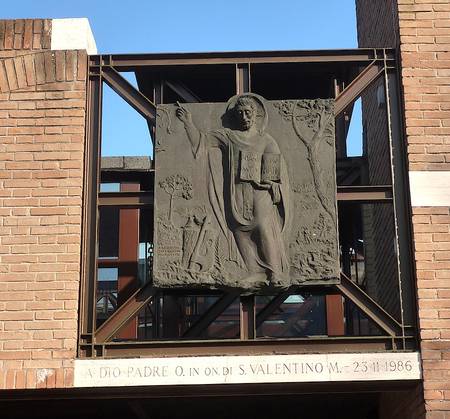‘St Valentine at the Milvian Bridge’ was an early Christian basilica situated outside the walls to the north of Rome. The true identity of Valentine, the saint to whom it is dedicated, is obscure, though one tradition makes him an early bishop martyred on the Via Flaminia, the continuation of the Corso which runs north from the city centre, on 14th February 273. His remains were buried nearby. The spot soon became a Christian burial ground, and the basilica was built in the fourth century. It flourished until St Valentine’s relics were taken to a more central location, to the church of Santa Maria in Cosmedin (site of the famous Bocca della Verità). This so-called ‘translation’ of relics became common practice after the emperor Theodosius I passed a series of acts between 378 and 380 declaring Christianity the official religion of the empire. Although at first loth to convert pagan temples into their own sacred buildings, the early Christians gradually overcame their aversion and began adapting structures in central Rome as churches, consecrating them with the bones of martyrs brought in from the old, outlying burial sites.
St Valentine’s original basilica exists only as a ruin today, attached to catacombs dug into the Parioli hill. Traditionally the site was open to the public on St Valentine’s Day, but the complex is extremely unstable: of the basilica that had been enlarged and embellished by that tireless beautifier of martyrs’ shrines, Pope Honorius I, nothing at all remains to be seen.
A little further north, however, in the Olympic Village built for the Games of 1960, there is the modern church of San Valentino, consecrated in 1986. This is a remote location, and on the feast day of the saint, few seek out his church. Millions are scurrying around with cellophane-wrapped flowers, and blood-red fluffy hearts are dangling in every gift-shop window. But in the church of St Valentine only a subdued Mass is taking place in a side room.

The spirit of the saint lives on in the tradition whereby lovers attach padlocks to the nearby Milvian Bridge as a symbol of their indivisible attachment to each other. Though the padlocks were removed by the municipal authorities in 2012, they are slowly returning. The association of St Valentine with lovers comes from the date of his martyrdom, 14th February, the day when, according to old lore, mating birds choose their nesting partners.

The basilica of St Valentine is one of twenty-three churches visited on pilgrimage by Sigeric, newly-elected Archbishop of Canterbury, in 989. You can follow in his footsteps in Pilgrim’s Rome: A Blue Guide Travel Monograph, from which the above text is extracted.






